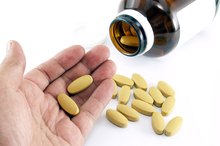What does fact checked mean?
At Healthfully, we strive to deliver objective content that is accurate and up-to-date. Our team periodically reviews articles in order to ensure content quality. The sources cited below consist of evidence from peer-reviewed journals, prominent medical organizations, academic associations, and government data.
The information contained on this site is for informational purposes only, and should not be used as a substitute for the advice of a professional health care provider. Please check with the appropriate physician regarding health questions and concerns. Although we strive to deliver accurate and up-to-date information, no guarantee to that effect is made.
Rash From Folic Acid
Skin rashes have numerous causes, but are usually the result of either too much or too little of something. Overdosing on medications is a common cause of skin rashes and hives because the body attempts to secrete some of the toxic metabolites through the skin, which causes irritation. Skin rashes from too much folic acid supplementation are rare because it is water-soluble and easily flushed out of the body, but some instances have been reported. Consult with your dermatologist if you have a persistent skin rash.
Folic Acid
Folic acid is the synthetic version of folate, which is also called vitamin B-9. Folate is found in a fairly wide variety of foods and is completely non-toxic, so it doesn’t cause any known overdose symptoms, according to the book “Advanced Nutrition and Human Metabolism." Folic acid is used for supplementation and fortification of certain foods, such as breakfast cereals and some brands of rice. Folic acid also exhibits low toxicity and is considered safe as a supplement because it is water-soluble, but daily requirements are usually given in micrograms, which some people mistake for milligrams and accidentally take far more than intended.
- Folic acid is the synthetic version of folate, which is also called vitamin B-9.
- Folic acid also exhibits low toxicity and is considered safe as a supplement because it is water-soluble, but daily requirements are usually given in micrograms, which some people mistake for milligrams and accidentally take far more than intended.
Folic Acid Recommendations
How Much Thiamine & Benfotiamine Is a High Dose?
Learn More
According to the National Institutes of Health, or NIH, adults should consume 400 micrograms of folate from food daily, which equates to about 240 micrograms of folic acid because the synthetic version has higher bioavailability 2. Pregnant women need more folate, at least 600 micrograms daily, because of the vitamin’s crucial role in proper fetal development, especially during the first 12 weeks. In fact, folic acid supplementation dramatically reduces birth defects such as spina bifida. NIH also recommends an upper tolerable intake of folate at 1,000 micrograms daily, although toxicity levels have never been established.
- According to the National Institutes of Health, or NIH, adults should consume 400 micrograms of folate from food daily, which equates to about 240 micrograms of folic acid because the synthetic version has higher bioavailability 2.
Folic Acid and Skin Rash
According to Drugs.com, allergic reactions have been reported following both oral and parenteral administration of folic acid, but they are rare 3. The allergic responses to folic acid include erythema, skin rash, itching, general malaise and respiratory difficulty. Reported dosages are on the order of 15 mg daily for many days or weeks, which is between 30 and 40 times more than recommended levels. Other symptoms related to folic acid overdose can include:
- gastrointestinal upset
- diarrhea
- altered sleep patterns
- concentration difficulties
- irritability
- depression
- confusion
- impaired judgment
- According to Drugs.com, allergic reactions have been reported following both oral and parenteral administration of folic acid, but they are rare 3.
Cautions
Chromium Dinicotinate Glycinate Dangers
Learn More
Aside from potential skin rashes, taking large dosages of folic acid can cover up a vitamin B-12 deficiency because the two vitamins have overlapping functions. For example, taking large doses of folic acid can prevent the anemia caused by B-12 deficiency, but not the cognitive symptoms that very much resemble Alzheimer’s disease. As such, elderly people are at risk of masking a deficiency that can cause symptoms to be misdiagnosed as senility. Talk to your doctor about appropriate levels of vitamins and related deficiency symptoms.
- Aside from potential skin rashes, taking large dosages of folic acid can cover up a vitamin B-12 deficiency because the two vitamins have overlapping functions.
Related Articles
References
- “Advanced Nutrition and Human Metabolism”; Sareen Gropper et al; 2009
- National Institutes of Health: Office of Dietary Supplements: Folate Fact Sheet
- Drugs.com: Folic Acid Side Effects
- Donnelly JG. Folic acid. Crit Rev Clin Lab Sci. 2001;38(3):183-223.
- Scaglione F, Panzavolta G. Folate, folic acid and 5-methyltetrahydrofolate are not the same thing. Xenobiotica. 2014;44(5):480-8.
- Figueiredo JC, Grau MV, Haile RW, et al. Folic acid and risk of prostate cancer: results from a randomized clinical trial. J Natl Cancer Inst. 2009;101(6):432–435. doi:10.1093/jnci/djp019
- Spina bifida and anencephaly before and after folic acid mandate--United States, 1995-1996 and 1999-2000. MMWR Morb Mortal Wkly Rep. 2004;53(17):362-5.
- Bastian H. Lucy Wills (1888-1964): the life and research of an adventurous independent woman. J R Coll Physicians Edinb. 2008;38(1):89-91.
- Visentin M, Zhao R, Goldman ID. The antifolates. Hematol Oncol Clin North Am. 2012;26(3):629–ix. doi:10.1016/j.hoc.2012.02.002
- Greenberg JA, Bell SJ, Guan Y, Yu YH. Folic Acid supplementation and pregnancy: more than just neural tube defect prevention. Rev Obstet Gynecol. 2011;4(2):52–59.
- Northrup H, Volcik KA. Spina bifida and other neural tube defects. Curr Probl Pediatr. 2000;30(10):313-32.
- Crider KS, Bailey LB, Berry RJ. Folic acid food fortification-its history, effect, concerns, and future directions. Nutrients. 2011;3(3):370–384. doi:10.3390/nu3030370
- Fousekis FS, Theopistos VI, Katsanos KH, Tsianos EV, Christodoulou DK. Hepatobiliary Manifestations and Complications in Inflammatory Bowel Disease: A Review. Gastroenterology Res. 2018;11(2):83–94. doi:10.14740/gr990w
- Hariz A, Bhattacharya PT. Megaloblastic Anemia. [Updated 2019 Jan 23]. In: StatPearls [Internet]. Treasure Island (FL): StatPearls Publishing; 2019 Jan-. Available from: https://www.ncbi.nlm.nih.gov/books/NBK537254/
- Maron BA, Loscalzo J. The treatment of hyperhomocysteinemia. Annu Rev Med. 2009;60:39–54. doi:10.1146/annurev.med.60.041807.123308
- Tinelli C, Di Pino A, Ficulle E, Marcelli S, Feligioni M. Hyperhomocysteinemia as a Risk Factor and Potential Nutraceutical Target for Certain Pathologies. Front Nutr. 2019;6:49. Published 2019 Apr 24. doi:10.3389/fnut.2019.00049
- Juhlin L, Olsson MJ. Improvement of vitiligo after oral treatment with vitamin B12 and folic acid and the importance of sun exposure. Acta Derm Venereol. 1997;77(6):460-2.
- Merle BM, Silver RE, Rosner B, Seddon JM. Dietary folate, B vitamins, genetic susceptibility and progression to advanced nonexudative age-related macular degeneration with geographic atrophy: a prospective cohort study. Am J Clin Nutr. 2016;103(4):1135-44.
- Tian T, Yang KQ, Cui JG, Zhou LL, Zhou XL. Folic Acid Supplementation for Stroke Prevention in Patients With Cardiovascular Disease. Am J Med Sci. 2017;354(4):379-387.
- Hsu CY, Chiu SW, Hong KS, et al. Folic Acid in Stroke Prevention in Countries without Mandatory Folic Acid Food Fortification: A Meta-Analysis of Randomized Controlled Trials. J Stroke. 2018;20(1):99–109. doi:10.5853/jos.2017.01522
- McRae MP. High-dose folic acid supplementation effects on endothelial function and blood pressure in hypertensive patients: a meta-analysis of randomized controlled clinical trials. J Chiropr Med. 2009;8(1):15–24. doi:10.1016/j.jcm.2008.09.001
- Zhao G, Ford ES, Li C, Greenlund KJ, Croft JB, Balluz LS. Use of folic acid and vitamin supplementation among adults with depression and anxiety: a cross-sectional, population-based survey. Nutr J. 2011;10:102.
- Gisondi P, Fantuzzi F, Malerba M, Girolomoni G. Folic acid in general medicine and dermatology. J Dermatolog Treat. 2007;18(3):138-46.
- Reynolds EH. Folic acid, ageing, depression, and dementia. BMJ. 2002;324(7352):1512–1515. doi:10.1136/bmj.324.7352.1512
- Nucera E, Aruanno A, Mezzacappa S, Pascolini L, Buonomo A, Schiavino D. Hypersensitivity reactions to folic acid: Three case reports and a review of the literature. Int J Immunopathol Pharmacol. 2018;32:2058738418817704. Published 2018 Dec 17. doi:10.1177/2058738418817704
- Pieroth R, Paver S, Day S, Lammersfeld C. Folate and Its Impact on Cancer Risk. Curr Nutr Rep. 2018;7(3):70–84. doi:10.1007/s13668-018-0237-y
- Lewis DP, Van dyke DC, Willhite LA, Stumbo PJ, Berg MJ. Phenytoin-folic acid interaction. Ann Pharmacother. 1995;29(7-8):726-35.
- Selhub J, Dhar GJ, Rosenberg IH. Inhibition of folate enzymes by sulfasalazine. J Clin Invest. 1978;61(1):221-4.
- Kennedy DO. B Vitamins and the Brain: Mechanisms, Dose and Efficacy--A Review. Nutrients. 2016;8(2):68. Published 2016 Jan 27. doi:10.3390/nu8020068
- Starr RR. Too little, too late: ineffective regulation of dietary supplements in the United States. Am J Public Health. 2015;105(3):478–485. doi:10.2105/AJPH.2014.302348
- Troesch B, Demmelmair J, Gimpfl M, et al. Suitability and safety of L-5-methyltetrahydrofolate as a folate source in infant formula: A randomized-controlled trial. PLoS One. 2019;14(8):e0216790. Published 2019 Aug 19. doi:10.1371/journal.pone.0216790
- Pintó X, Vilaseca MA, Balcells S, et al. A folate-rich diet is as effective as folic acid from supplements in decreasing plasma homocysteine concentrations. Int J Med Sci. 2005;2(2):58–63. doi:10.7150/ijms.2.58
- American Academy of Pediatrics: Committee on Genetics. Folic acid for the prevention of neural tube defects. Pediatrics. 1999 Aug;104(2 Pt 1):325-7.
- Juhlin, L. and Olsson, M. Improvement of vitiligo after oral treatment with vitamin B12 and folic acid and the importance of sun exposure. Acta Derm Venereol. 1997 Nov;77(6):460-2. DOI: 10.2340/000155555577460462.
- Li, Y.; Huang, T.; Zheng, Y. et al. Folic Acid Supplementation and the Risk of Cardiovascular Diseases: A Meta‐Analysis of Randomized Controlled Trials. JAHA. 2016;5(8):pii: e003768. DOI: 10.1161/JAHA.116.003768.
- Merle, B.; Silver, R.; Rosner, B. et al. Dietary folate, B vitamins, genetic susceptibility and progression to advanced nonexudative age-related macular degeneration with geographic atrophy: a prospective cohort study. Am J Clin Nutr. 2016 Apr;103(4):1135-44. DOI: 10.3945/ajcn.115.117606.
- Zhao, G.; Ford, E.; Li, C. et al. Use of folic acid and vitamin supplementation among adults with depression and anxiety: a cross-sectional, population-based survey. Nutrition Journal. 2011;10:102. DOI: 10.1186/1475-2891-10-102.
Writer Bio
Sirah Dubois is currently a PhD student in food science after having completed her master's degree in nutrition at the University of Alberta. She has worked in private practice as a dietitian in Edmonton, Canada and her nutrition-related articles have appeared in The Edmonton Journal newspaper.









